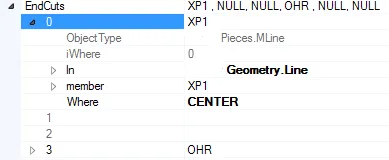我有许多自定义类,我将解释并发布示例。在说明它们的功能后,我将尝试清楚地描述出现错误的条件。
首先,我使用PropertyGrid来显示几种不同类型对象的属性。因为PropertyGrid的默认绑定不像我想要的那么描述性,所以我创建了一些自定义类,我将引用它们为“Display”类。这些Display类是通过传入一个对象并创建属性来构造的,这些属性返回漂亮格式化的字符串和描述,用于传递的真实对象的公共属性(在某些情况下还包括方法)。
我将用以下缩写示例代码进行演示:
这是一个我想在我的PropertyGrid中显示的对象示例:
public class Joint
{
public Joint(...)
{...}
//properties
public string Name { get; set;}
public CustomObject CC { get; set;}
public List<CustomObject> Custom List { get; set;}
}
字符串属性“Name”在PropertyGrid中显示正常。 然而,CustomObject和List的显示方式对我来说并不是很用户友好。
因此,我尝试通过编写这个类来解决问题:
public class DisplayJoint
{
private Joint _jnt;
public DisplayJoint(Joint jnt)
{
_jnt = jnt;
}
//properties
public string Name { get { return _jnt.Name; } }
[TypeConverterAttribute(typeof(ExpandableObjectConverter))]
public DisplayCustomObject CC { get { return new DisplayCustomObject(_jnt.CC); } }
[TypeConverterAttribute(typeof(ExpandableObjectConverter))]
public List<CustomObject> CustomList { get; set;}
}
如上所示的代码,我为我的Joint类和CustomObject类创建了特殊的DisplayClasses。在我的项目中,有许多不同类型的对象需要相同的重叠显示类属性。
如上所示,您可以看到我添加的行位于最后两个属性之上。
此行解决了我在propertGrid中想要以我想要的方式显示CustomObject的问题(几乎...稍后再说)。但是,对于我的自定义列表属性,它的工作方式并不相同。在自定义列表上,它会展开以仅显示Count和capacity(List的实际属性)。这是有道理的,但这不是我想要的。我想看到列表中包含的实际对象。

这里是我的复杂解决方案,最初来源于这个问题。我有两个类,用于动态添加对象到属性表格绑定列表中作为属性。第一个类(CustomClass)可以在此处下载。它用于动态创建属性。我使用的第二个类(DisplayIEnumerable)从第一个类派生而来,在此处找到。
DisplayIEnumerable类循环遍历列表对象,并向自身添加一个属性,其中包含每个对象的信息。传入DisplayClass以定义如何在网格中表示这些对象属性。
到目前为止,一切都很好!如下图所示(图片不是使用提供的类创建的,字符串在我使用的类中格式不同,已删除格式化代码以帮助你专注于相关代码:

这是我已经尝试并遇到错误的类。我还没有尝试使用我的 DisplayIEnumerable 类替换列表,我想先让基本功能正常工作:
using System;
using System.ComponentModel;
using System.Collections.Generic;
using System.Reflection;
using System.Collections;
using System.Windows.Forms;
internal class DisplayObject : CustomClass<T>
{
#region Variables
protected T _obj;
#endregion
#region Constructor
public DisplayObject(T obj)
{
if (obj != null)
{
try
{
Type currentType = typeof(T);
foreach (PropertyInfo propertyInfo in currentType.GetProperties())
{
Attribute[] attributes = new Attribute[1];
if (propertyInfo.GetType() is IEnumerable)
attributes[0] = new TypeConverterAttribute(typeof(ExpandableObjectConverter));
else
attributes[0] = null;
this.Add(new CustomProperty(propertyInfo.Name, propertyInfo, propertyInfo.GetType(), false, true, attributes));
}
}
catch
{
MessageBox.Show("Failure!");
}
}
}
#endregion
#region Properties
[Browsable(false)]
public object Item
{
get { return _obj; }
set { _obj = value; }
}
#endregion
}
当运行时,属性网格看起来应该是这样的:
 然而,一旦您点击展开箭头,什么也不会发生,箭头就会消失:
然而,一旦您点击展开箭头,什么也不会发生,箭头就会消失:
 上面的类有什么问题,而我的DisplayIEnumerable类没有问题,导致这种行为差异?
上面的类有什么问题,而我的DisplayIEnumerable类没有问题,导致这种行为差异?我像这样使用DisplayObject类(在DisplayClass中):
[TypeConverterAttribute(typeof(ExpandableObjectConverter))]
public DisplayObject EndJoint { get { if (_member.bcEnd != null) { return new DisplayObject(_member.EndJoint); } else return null; } }
提前感谢!如果有人能回答这个问题,我会非常印象深刻。
